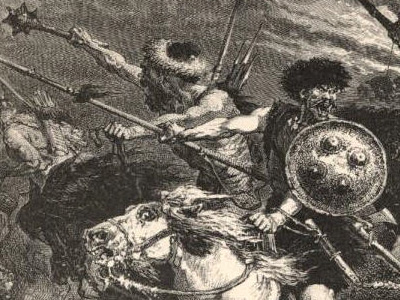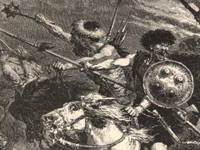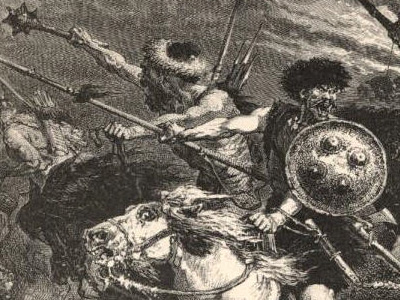Battle of Châlons (451 AD)

Battle
Upon learning of the invasion, the Magister Utriusque Militiae Flavius Aetius moved his army quickly from Italy into Gaul. According to Sidonius Apollinaris, he was leading forth a force consisting of few and sparse auxiliaries without one regular soldier. Hughes argues the insignificant number of Roman troops reported is due to the fact the majority of Aetius' army was stationed in Gaul. He immediately attempted to convince Theodoric I, king of the Visigoths, to join him. Allegedly Theodoric learned how few troops Aetius had with him and decided it was wiser to wait to oppose the Huns in his own lands, so Aetius turned then to the former Praetorian Prefect of Gaul, Avitus, for help. Supposedly Avitus was not only able to convince Theodoric to join with the Romans, but also a number of other wavering barbarian residents in Gaul. Hughes suggests the coalition probably assembled at Arles before moving to meet the Goths at Toulouse, and that the army was supplied by Tonantius Ferreolus who had been preparing for a Hunnic attack for a few years prior. The combined armies then marched to Aurelianum (Orléans), reaching that city on June 14.

The Huns at the Battle of Chalons by Alphonse de Neuville (1836–85)
Aetius and his coalition began to pursue Attila, whom Kim argues was leaving Gaul with the majority of his objectives completed. According to Jordanes, the night before the main battle, some of the Franks allied with the Romans encountered a band of the Gepids loyal to Attila and engaged them in a skirmish. Jordanes' recorded number of 15,000 dead on either side for this skirmish is not verifiable. MacDowall suggests that Attila had set up a tactical delay along his route of retreat in order to keep Aetius from catching him before he arrived at a suitable battlefield location. The two forces at last met somewhere on the Catalaunian Fields circa June 20, a date first proposed by J.B. Bury and since accepted by many, although some sources claim September 20.
Allegedly, Attila had his diviners examine the entrails of a sacrifice the morning of the day of the battle. They foretold disaster would befall the Huns, but one of the enemy leaders would be killed. Attila delayed until the ninth hour (about 2:30 PM) so the impending sunset would help his troops to flee the battlefield in case of defeat. Hughes takes his own interpretation of this, noting that the divination may be an emphasis of Attila's barbarity and therefore possibly a fabrication. He states that the choice to begin the battle at the ninth hour was due to the fact both sides spent the whole day carefully deploying their coalition armies.
According to Jordanes, the Catalaunian plain rose on one side by a sharp slope to a ridge; this geographical feature dominated the battlefield and became the center of the battle. The Huns first seized the right side of the ridge, while the Romans seized the left, with the crest unoccupied between them. Jordanes explains that the Visigoths held the right side, the Romans the left, with Sangiban of uncertain loyalty and his Alans surrounded in the middle. The Hunnic forces attempted to take the ridge, but were outstripped by the Romans under Aetius and the Goths under Thorismund.
Jordanes goes on to state that Theodoric, whilst leading his own men against the enemy Goths, was killed in the assault without his men noticing. He then states that Theodoric was either thrown from his horse and trampled to death by his advancing men, or slain by the spear of the Goth Andag. Since Jordanes served as the notary of Andag's son Gunthigis, even if this latter story is not true, this version was certainly a proud family tradition.
Then Jordanes claims the Visigoths outstripped the speed of the Alans beside them and fell upon Attila's own Hunnic household unit. Attila was forced to seek refuge in his own camp, which he had fortified with wagons. The Romano-Gothic charge apparently swept past the Hunnic camp in pursuit; when night fell, Thorismund, son of king Theodoric, returning to friendly lines, mistakenly entered Attila's encampment. There he was wounded in the ensuing melee before his followers could rescue him. Darkness also separated Aetius from his own men. As he feared that disaster had befallen them, he spent the rest of the night with his Gothic allies.
On the following day, finding the battlefield was "piled high with bodies and the Huns did not venture forth", the Goths and Romans met to decide their next move. Knowing that Attila was low on provisions and "was hindered from approaching by a shower of arrows placed within the confines of the Roman camp", they started to besiege his camp. In this desperate situation, Attila remained unbowed and "heaped up a funeral pyre of horse saddles, so that if the enemy should attack him, he was determined to cast himself into the flames, that none might have the joy of wounding him and that the lord of so many races might not fall into the hands of his foes".
While Attila was besieged in his camp, the Visigoths searched for their missing king and his son Thorismund. After a long search, they found Theodoric's corpse "where the dead lay thickest" and bore him away with heroic songs in sight of the enemy. Upon learning of his father's death, Thorismund wanted to assault Attila's camp, but Aetius dissuaded him. According to Jordanes, Aetius feared that if the Huns were completely destroyed, the Visigoths would break off their allegiance to the Roman Empire and become an even graver threat. So Aetius convinced Thorismund to quickly return home and secure the throne for himself, before his brothers could. Otherwise, civil war would ensue among the Visigoths. Thorismund quickly returned to Tolosa (present-day Toulouse) and became king without any resistance. Gregory of Tours claims Aetius used the same reasoning to dismiss his Frankish allies, and collected the booty of the battlefield for himself.
HISTORY

RESOURCES
This article uses material from the Wikipedia article "Battle of the Catalaunian Plains", which is released under the Creative Commons Attribution-Share-Alike License 3.0.
© Stories Preschool. All Rights Reserved.









